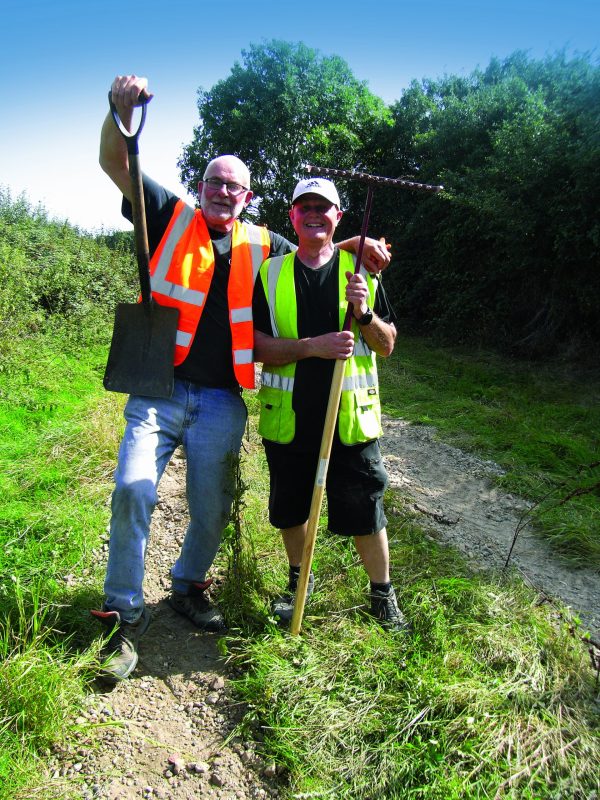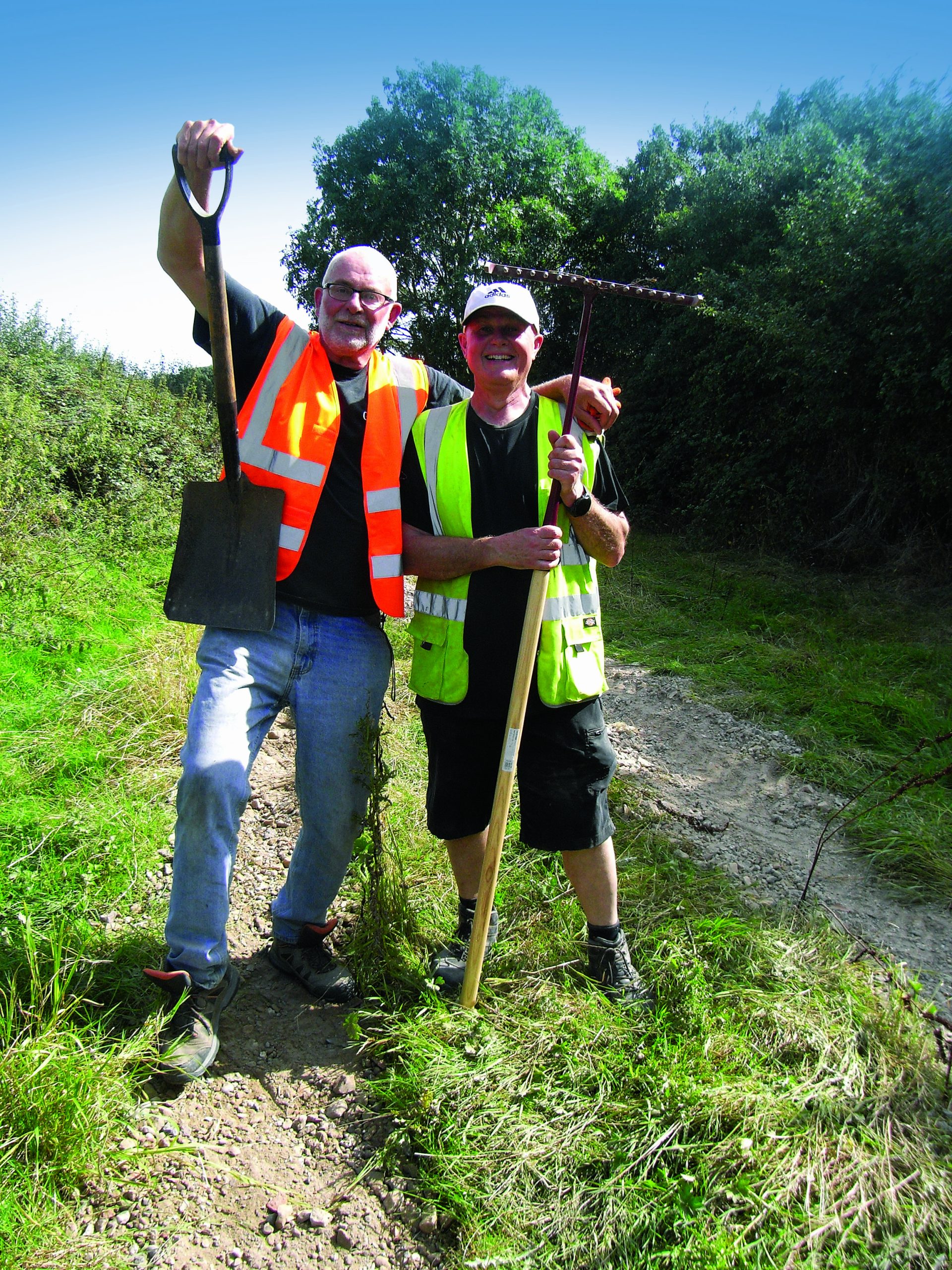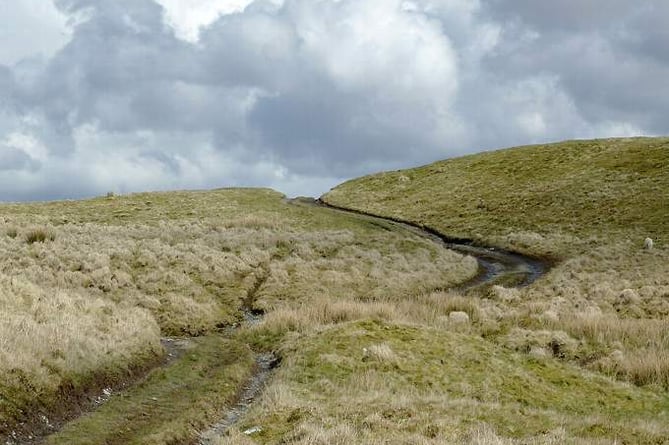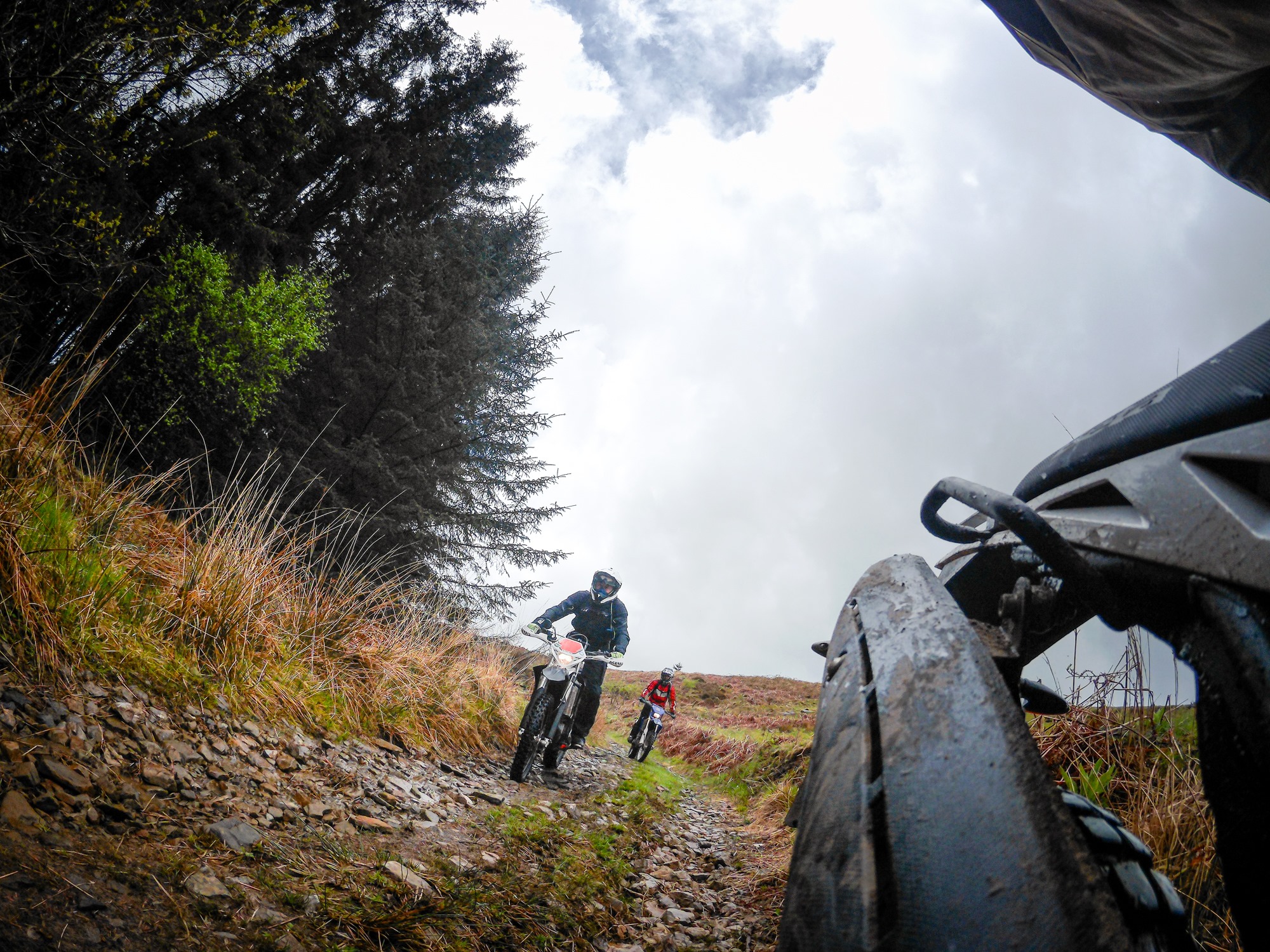Redmile reconstructed
Lincolnshire TRF, spotting a TRO on their patch, investigated, saw a mountain of work – and proceeded anyway! The result? A TRO lifted, a valuable link restored and a community served
Inspired to get working on some green road conservation, at the back end of 2022 one of the Lincolnshire TRF members (Byron) noticed that two byways near Redmile – in Leicestershire, not Lincolnshire – were on the Council’s winter TRO list and suggested that the group might investigate with a view to carrying out repairs.
Contact was made with the Council and with Dan, the East Midlands TRF Group ROW officer. Both were open to a proposal for repairs to be made. The Council could not afford to do it and the East Midlands Group wasn’t that concerned as the byways in question were on the very edge of its area, little used by its members and appeared to end at a restricted byway.
A preliminary survey of the byways in January 2023 showed them to be in a poor state: big ruts, very wet with boggy areas and one water-filled ‘bomb-hole’. The local farmer had been unable to get his machinery on the byway to cut back the encroaching brambles and the bomb-hole made it dangerous when moving his cattle between fields.
First steps
The Lincolnshire Group members were initially not particularly enthusiastic about the time required and expense of repairing a route that is not even in Lincolnshire and that appeared to be a dead-end for motorised traffic. However, an email exchange with the ROW department of Leicestershire County Council confirmed that, while Church Lane at the north-east end of Byway G9 is technically a restricted byway, it considers this to be a ‘glitch’ from NERC and stated that measures were in the pipeline to correct the situation. No-one would be prosecuted for using a motor vehicle on Church Lane. Once this was cleared up, and since we use the route to link in with our regular rides around the ‘Melton Loop’, the plan got the group’s go-ahead. There was no way that we could cope with repairs to both byways, so an initial proposal, for repairing only the southern Byway G9, was prepared and submitted to the Council.
We were then asked to present our plans at a Local Parish Council meeting! The Parish Council did not exactly welcome the idea. The locals were fed up with night-time ‘raids’ on the byway by mixed groups of 4x4s, quads and a few bikes, many of which came from miles away to tackle the bomb-hole (which usually resulted in lots of shouting, revving of motors and winching at 3.00am). The Parish Council was of the opinion that repairing the route and lifting the TRO would make matters worse. We pointed out that the people causing the issue were ignoring the TRO anyway (as were local dog walkers) and that if the bomb-hole were to be repaired, then the byway would become less challenging and therefore less attractive to the ‘winch appreciation society’.
The Council seemed to accept this argument and mellowed a little. Its members also admitted that they had no power to stop us anyway! The best thing that we got from the meeting was the contact details for the farmer (Andy), who works the land around the byway.
Andy was duly contacted and was prepared to meet us. Although he was initially dubious about the whole thing, the meeting proved very productive. We left with an offer to use his yard as a base for the repair operations (car parking, temporary storage of the pile of aggregate and the plant to load it). His farm has its own access to the byway, which meant that we would not have to drive dumper loads of stone along Church Lane or move it the whole length of the byway from the Long Lane end.
Before....
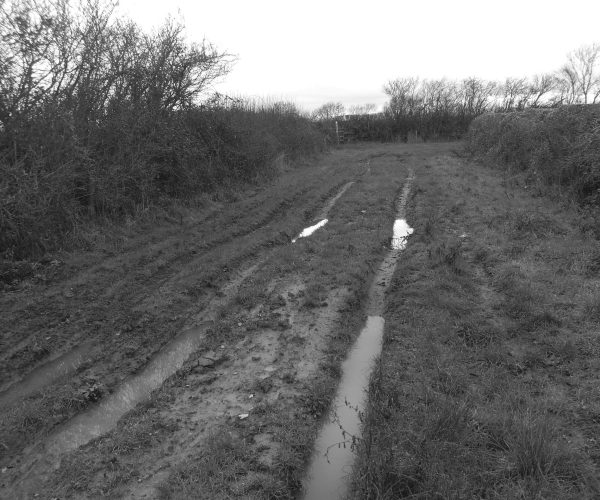
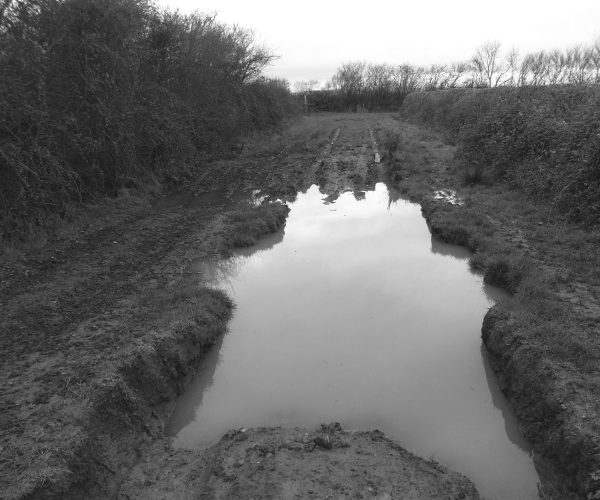
Second Survey
Time to get serious! Another more detailed survey was done to measure the ruts and holes in order to estimate the volume of fill material needed, the plant needed to handle it, and the manpower and time it would actually take. The Council wanted a more detailed work scope document, a risk assessment and proof of insurance. It also stipulated the specification of the fill material.
But the paperwork should not put anyone off – it’s all quite simple and there are templates on the internet (Conservation Paperwork, p30).
The second survey also revealed that the amount of aggregate and manpower required to repair the whole length of the byway was prohibitive (over 200 tonnes of aggregate). This, and a weakness in a culvert crossing under the byway (revealed by farmer Andy) meant that we had to scale back our ambitions and concentrate our effort on the village end of the byway; luckily this section included the bomb-hole (8m long, 3m wide, 1.5m deep) and the worst of the boggy bits.
Quotes were obtained for the aggregate, volunteer group members were recruited by creating a Group event posted on Facebook, and plant was booked (luckily, some group members worked for a local plant-hire company and volunteered to operate the digger and dumper needed – which covered off operator licensing). This just left the finances! Group funds were raided, the TRF was approached with a bid for match-funding (which was immediately approved), the East Midlands Group made a generous contribution but the Council didn’t (empty coffers, like so many councils).
...during...
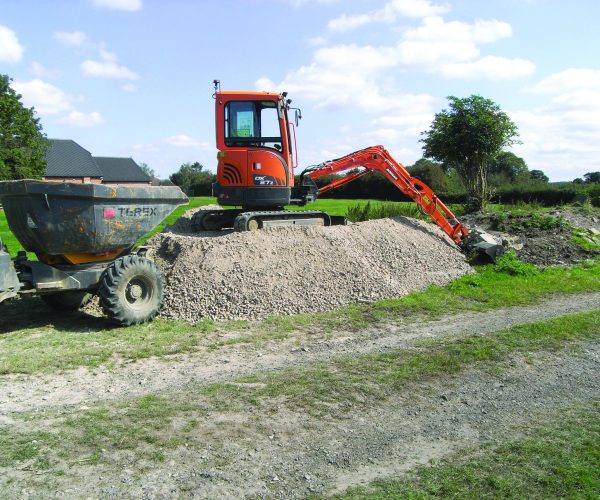
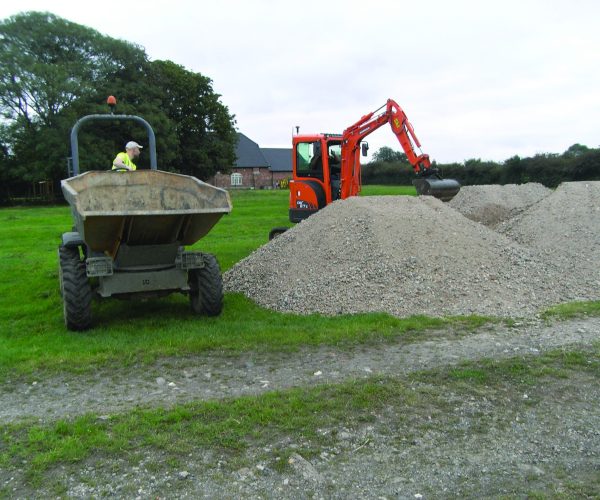
On site
The original date planned (mid-April) was rejected by the plant operators as they considered that the ground would still be too wet. The second planned date was scrubbed when the digger driver and the Group Chairman opted to take their bikes abroad instead – interest within the group was waning!
Eventually the planets aligned and on a Friday in the middle of June 100 tonnes of aggregate was delivered to farmer Andy’s yard, Alyson Plant Hire dropped off a digger and a three-tonne dumper, and we were good to go for the weekend.Saturday morning, a 7.30am start, and six people turned up: the Group Chairman (Nev), digger driver (Steve), the organiser (Byron), me (Clive) and two other group members (Bill and Carl).After a walk-through of the byway to familiarise everyone with the layout and scale of the job ahead, the first load of aggregate was loaded and off we went.
The single most important part of the job was to fill the bomb-hole; to this end we worked our way along the byway from the gate at the village end towards the hole, making the minimum repairs necessary to protect the surface from the repeated passage of the dumper. Once the bomb-hole was filled and levelled, we would know how much aggregate was left to complete the rest of the work and improve the minimalist repairs. That hole swallowed an awful lot of aggregate!
Working beyond the hole it quickly became apparent that our intended method of work, that is dumping the aggregate in a pile and then raking it into the bogs and ruts, was seriously hard work, especially with only four people (down to three after lunch). The dumper driver tried to spread the load in a thin(ish) layer to reduce the amount of raking, but the aggregate was damp and tended to trickle out initially and then slump in one big dollop. The aggregate specified was actually recycled demolition rubble with a maximum particle size of 100mm (and lots of dust).
...after
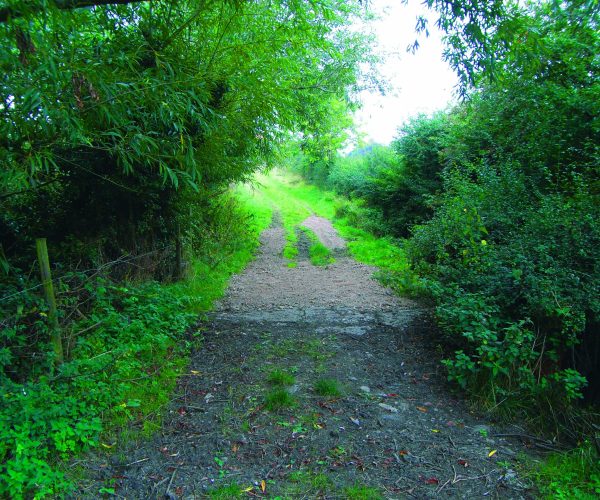
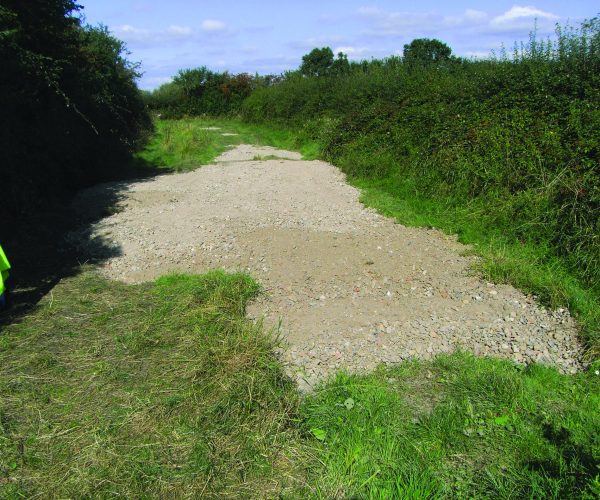
It was found to be quicker and less strenuous to position the dumper where we wanted the aggregate and then rake the required amount out of the slightly tilted dumper hopper. This worked really well for ruts as the dumper could rotate its hopper 90-degrees to allow aggregate to be raked into the rut alongside the dumper before moving a few yards along the rut and repeating the process.
When repairs to the section beyond the bomb-hole were complete, the remaining aggregate was used to work back to the village end of the byway, filling ruts and improving the minimalist repairs made earlier in the day. Work was completed by about 16.30pm.
The Council sent their people to give the job a once-over, the work was deemed acceptable, the TRO was lifted and the Council even put up a couple of signs. The village can sleep at night and we have back a crucial link in our loop. Plus you can’t over-state the feel good factor of having ‘helped’. And maybe that’s addictive, as we’re now surveying for other byways that could do with some TLC…
